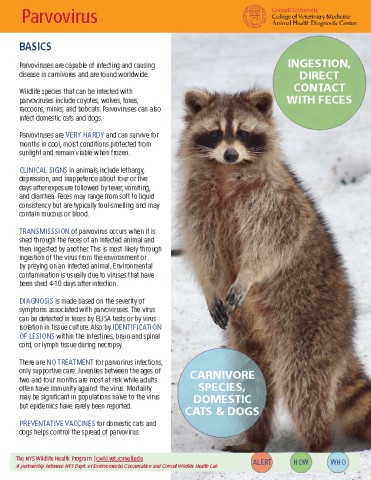Parvovirus Outbreaks in Raccoons
Parvovirus outbreaks are often reported in raccoon kits at rehabilitation facilities in the summer and early fall where it can sweep through animals causing high numbers of mortalities. It can be very difficult to treat and control once a facility is contaminated. Quarantine, vaccination and good hygiene can help prevent transmission of parvo and other diseases to healthy kits.
Parvoviruses are highly infectious, environmentally persistent agents that infect carnivore species. Transmission occurs when the virus is shed through the feces of an infected animal and then ingested by another. Young animals are at greatest risk of infection, especially littermates of an already infected animal. Stress, intestinal parasites, or concurrent GI infections can lead to more severe clinical illness.
Detection
Clinical signs in animals include lethargy, depression, and inappetence about four or five days after exposure followed by fever, vomiting, and diarrhea. Feces may range from soft to liquid consistency, but are usually foul-smelling and may contain mucous or blood. The virus can be detected in feces by ELISA tests or by virus isolation in tissue culture.
The SNAP Parvo test detects parvovirus antigen in feces, and does not cross-react with parvovirus vaccinations.
It is important to note that a negative result does not completely rule out parvovirus infection. If an animal has been exposed to parvovirus but is not actively shedding yet you may see a false negative result. Fecal shedding of parvovirus antigen at detectable levels typically occurs between 3-12 days post-exposure and usually correlates with the onset of clinical signs. However, shedding can both begin before the onset of clinical signs and - in pups with moderate maternal antibody levels - be delayed by 1-2 days relative to the onset of clinical signs.
It is important, therefore, to collect feces for viral detection at the onset of clinical illness and if negative for CPV, retest in 1-2 days to further evaluate for parvovirus. Virus shedding begins to wane by day 8-10 (post infection), but can last up to 14 days after recovery.
Prevention and Treatment
Unfortunately the only treatment available for parvovirus is supportive care. The primary concerns of infected animals are dehydration and hypoglycemia, so it is important to address these deficits while managing pain relief and proper nutrition. Ideally you can prevent infection in the first place.
Parvoviruses can also stay around for weeks on contaminated surfaces and serve as a source of new infections even in the absence of sick animals. Parvoviruses are resistant to many common detergents and disinfectants, as well as to changes in temperature and pH. Make sure to use parvocidal cleaners in your facilities. Dilute bleach is effective against parvovirus, along with disinfectants that contain chlorine, peroxygen, formaldehyde, glutaraldehyde, potassium peroxymonosulfate, or accelerated hydrogen peroxide.
Remove all organic debris before cleaning. (The presence of organic material such as feces can inactivate most disinfectants). Then wash the area or item with detergent and water before rinsing well and letting dry. Lastly, use the parvocidal disinfectant and allow proper contact time (generally at least 10 minutes) before rinsing.
There are several vaccinations available that can be administered. Every animal over 4 weeks of age should be vaccinated on intake, regardless of health status. Killed/inactivated virus vaccines are not recommended.
Merial Recombitek C3 or C4/CV is a combination vaccine that protects against Canine Parvovirus and Canine Distemper. This is a very safe vaccine that can be used both in young animals and in wildlife. The canine distemper portion is canarypox vectored recombinant while the canine parvovirus portion is modified live. The Recombitek C3 is a cheaper vaccine that lacks Coronavirus protection.
Nobivac Canine 1-DAPPv is a modified live combination vaccine that provides protection against canine parvovirus and distemper.
Merial PureVax Feline 4 is a modified live combination vaccine that provides protection against Feline Panleukopenia.
It’s important to note the effect of maternal antibody interference when vaccinating raccoon pups or any other young animal. Maternal antibody interference is the most common cause of vaccine failure, and is the reason vaccine boosters are needed every 2-3 weeks with the last dose administered when raccoon pups are >16 weeks.
Quarantine
Literature suggests that parvovirus often gives rise to less prominent clinical signs in raccoons than in other carnivores. Raccoons are susceptible to both canine and feline parvovirus as well as their own strain. As the general signs of parvovirus are nonspecific to begin with (lethargy, vomiting/diarrhea, loss of appetite, etc), mild symptoms can make it difficult to clearly define a clinical case.
Proper quarantine protocols are critical to prevent the spread of infection. New patients should be quarantined for at least 2 weeks (the incubation time for parvovirus) and ideally tested before being in contact with any other animals. It’s important to remember that quarantine and isolation are not the same. Quarantine is for susceptible animals that have potentially been exposed, while isolation is for infected/symptomatic animals. A parvovirus isolation space must be a separate, easily disinfected area with dedicated equipment and restricted access, and protective clothing should be required when entering the space (boots, gloves, water resistant clothing). Ideally, the isolation space should be a physically separate building. It is especially important that there be no crossover with juveniles and new intakes.




